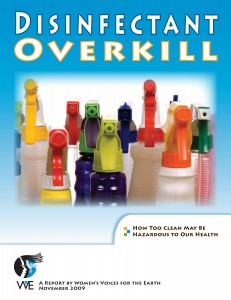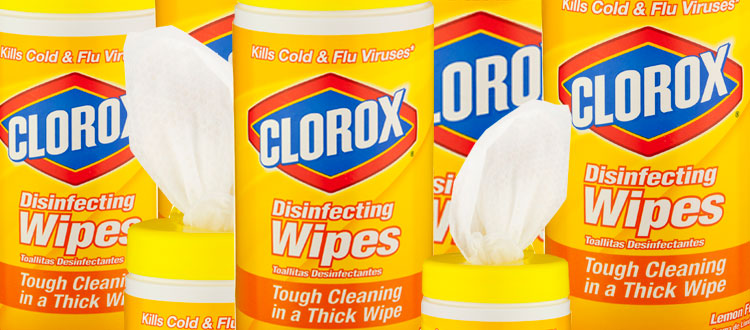Español – EL Uso Exagerado de los Desinfectantes
Common Antimicrobial Chemicals Found in Household Disinfectants
 Chlorine bleach is commonly used to treat drinking water, sanitize swimming pools and to whiten laundry, and is a strong eye, skin, and respiratory irritant. Mixing chlorine bleach with other cleaners like ammonia can release dangerous chlorine gas. Exposure to chlorine gas can cause coughing, shortness of breath, chest pain, nausea, or other symptoms.
Chlorine bleach is commonly used to treat drinking water, sanitize swimming pools and to whiten laundry, and is a strong eye, skin, and respiratory irritant. Mixing chlorine bleach with other cleaners like ammonia can release dangerous chlorine gas. Exposure to chlorine gas can cause coughing, shortness of breath, chest pain, nausea, or other symptoms.
Ammonia is often included in glass cleaners and other hard-surface cleaners, and can be irritating to the skin, eyes, throat, and lungs. Ammonia can burn your skin, and can damage your eyes (including blindness) upon contact.
Triclosan and Triclocarban are commonly added to household cleaning products such as hand soap and dish soap as well as a broad range of other products from toothpaste to socks. These chemicals are persistent in the environment, and are linked to hormone imbalance, and potential increased risk of breast cancer. [Update 9.2.16: VICTORY! The FDA has ruled a ban on antibacterial soaps containing triclosan, triclocarban and 17 other chemicals, but triclosan is still found in some products like toothpaste, cleaning products and cosmetics. Learn more.]
Ammonium quaternary compounds (“quats”) are found in household cleaning products like disinfectant sprays and toilet cleaners, and some have been identified as a known inducer of occupational asthma. Certain quats have also been linked to decreased fertility and birth defects in mice.
Nano-silver can be incorporated into textiles, plastics, soaps, packaging, and other materials, giving each the natural antibacterial property of silver metal. Nano-silver particles can penetrate deep into your body and have been shown to be toxic to the liver and brain.
As stories on the dangers of flu viruses, contaminated foods, and contagious illnesses proliferate in the media, advertisers increasingly try to convince consumers that antimicrobial cleaning products will protect their homes and families from infection. Likewise, manufacturers have capitalized on consumer fears by producing more products that contain antimicrobial chemicals. However, it is unnecessary to disinfect one’s homes to the degree that advertisers and manufacturers would have consumers believe.
Antimicrobial cleaning products (also known as disinfectants) are specifically intended to both clean surfaces and kill germs such as bacteria, viruses, or fungi. But research has shown that some of the most common antimicrobial chemicals used in cleaners could have serious health consequences, especially for women, cleaning workers, and young children. Also, the overuse of antimicrobials contributes to the growing problem of antibiotic-resistant bacteria, which some scientists say could leave the public with fewer tools in the fight against infectious diseases.
Women’s Voices for the Earth (WVE) produced this report to provide an alternative perspective on antimicrobial products and to shed light on the potential harm that the use and overuse of the chemicals in these products may be causing to human health. The report discusses the potential hazards of five commonly found classes of antimicrobial chemicals: chlorine bleach, ammonia, Triclosan and Triclocarban, ammonium quaternary compounds (“quats”), and nano-silver, a newly emerging chemical. Potential health impacts from these chemicals range from simple irritation of the eyes, skin, and respiratory system to hormone disruption and adverse impacts on the immune system.
This report is intended to encourage a prudent approach to the use of antimicrobial cleaners, and a return to safer and scientifically effective methods for keeping one’s home clean and healthy on a regular basis. It also offers consumers recommended actions for reducing their exposure to these potentially hazardous chemicals, as well as information on non-toxic cleaners with antimicrobial properties.
Download the full report, Disinfectant Overkill
Watch the Disinfectants Horror Show





